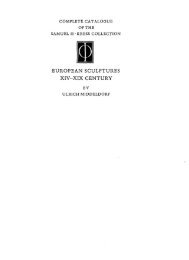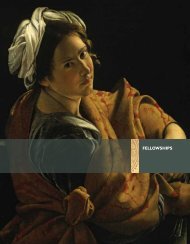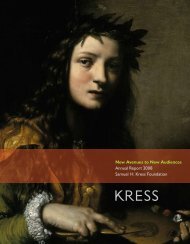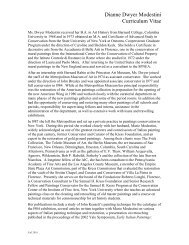The Campus Art Museum - Samuel H. Kress Foundation
The Campus Art Museum - Samuel H. Kress Foundation
The Campus Art Museum - Samuel H. Kress Foundation
Create successful ePaper yourself
Turn your PDF publications into a flip-book with our unique Google optimized e-Paper software.
<strong>The</strong> Power of the Original<br />
Incorporating the campus art museum into university and college teaching and<br />
research is not without challenges. Meeting with faculty to create individualized<br />
course use of the museum takes time for museum personnel, particularly if<br />
the staff person is also responsible for public school and community education<br />
programs. Co-teaching museum sessions with faculty also takes time for planning<br />
and preparation. A museum director commented on some of the challenges of<br />
working with faculty:<br />
<strong>The</strong>re’s a constant change of faculty and it’s not like you reach out to a<br />
discipline, you reach out to those faculty members. Each one of them uses you<br />
in different ways…. <strong>The</strong> good news is that the turnover becomes an opportunity<br />
to reach out to new faculty members before they have already established all<br />
the patterns of how they are going to teach something…. For older faculty, it’s<br />
harder… they’ve got their teaching schedule, they’ve got their classes, they’ve<br />
worked out how to do it and it’s a pain for them to try to change. With new<br />
faculty it’s easier, but that means there’s never an end to that effort.<br />
Academic curators mention how “one-offs can become a burnout,” that is,<br />
working with faculty to use the museum in their courses and finding that they do<br />
so only once. Some academic curators see that as a challenge to figure out ways in<br />
which they can be more proactive:<br />
We try to make it so you can’t just drop your students off and leave.… If<br />
professors are teaching the classes, they are more invested and they will<br />
do a better job. I want them to feel that they can teach and bring in their<br />
perspectives. <strong>The</strong>y don’t have to be made art historians to teach in the<br />
museum…. <strong>The</strong>re are various degrees of handholding. And the idea is that<br />
maybe you start off with a bit more handholding and eventually let go and<br />
hopefully you don’t lose them.<br />
Indeed, habitual museum-users often stated that they first collaborated with<br />
museum staff in using the collection in a class and then, as they grew in confidence,<br />
they continued to use the museum on their own.<br />
An increase in the number of faculty wanting to make use of the museum’s<br />
resources in storage is a further demand on museum staff. Time and care are<br />
involved in locating and moving art that can be heavy and fragile, and then the<br />
museum must have a safe place for its use. This is not always the case. As one<br />
registrar noted, they have tried to accommodate classes, but space is a problem:<br />
We sometimes will take objects into the seminar room upstairs… but we can’t<br />
really do that with paintings. Prints are a different thing. We have set a table<br />
up in the gallery and brought a bunch of stuff out…. We don’t have a room<br />
to set things up and leave it for a couple weeks or anything like that. Some<br />
museums do have that but we don’t have any space for that. So it’s a problem<br />
<strong>The</strong> Power of the Original<br />
30
















